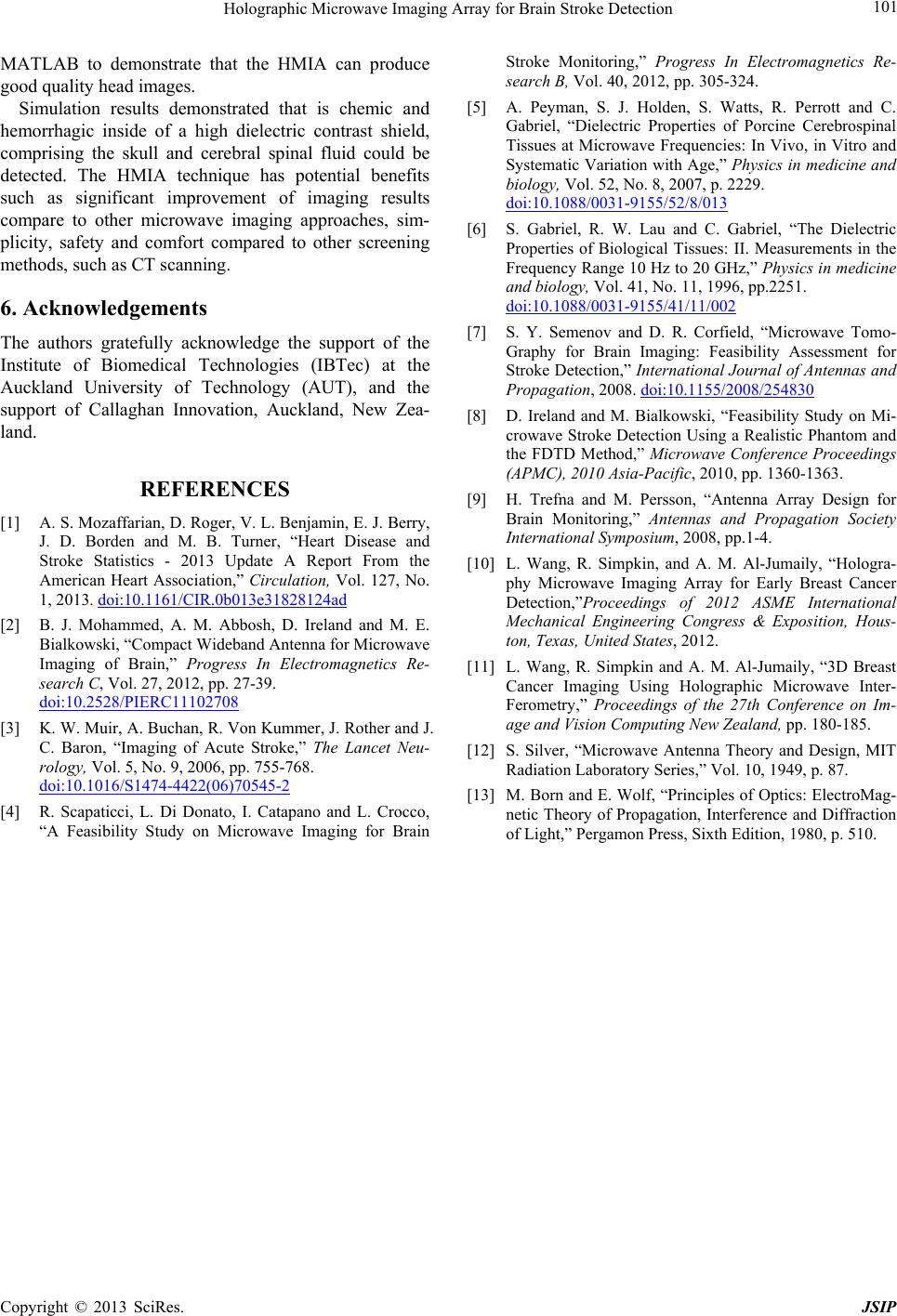
Holographic Microwave Imaging Array for Brain Stroke Detection
Copyright © 2013 SciRes. JSIP
101
MATLAB to demonstrate that the HMIA can produce
good quality head images.
Simulation results demonstrated that is chemic and
hemorrhagic inside of a high dielectric contrast shield,
comprising the skull and cerebral spinal fluid could be
detected. The HMIA technique has potential benefits
such as significant improvement of imaging results
compare to other microwave imaging approaches, sim-
plicity, safety and comfort compared to other screening
methods, such as CT scanning.
6. Acknowledgements
The authors gratefully acknowledge the support of the
Institute of Biomedical Technologies (IBTec) at the
Auckland University of Technology (AUT), and the
support of Callaghan Innovation, Auckland, New Zea-
land.
REFERENCES
[1] A. S. Mozaffarian, D. Roger, V. L. Benjamin, E. J. Berry,
J. D. Borden and M. B. Turner, “Heart Disease and
Stroke Statistics - 2013 Update A Report From the
American Heart Association,” Circulation, Vol. 127, No.
1, 2013. doi:10.1161/CIR.0b013e31828124ad
[2] B. J. Mohammed, A. M. Abbosh, D. Ireland and M. E.
Bialkowski, “Compact Wideband Antenna for Microwave
Imaging of Brain,” Progress In Electromagnetics Re-
search C, Vol. 27, 2012, pp. 27-39.
doi:10.2528/PIERC11102708
[3] K. W. Muir, A. Buchan, R. Von Kummer, J. Rother and J.
C. Baron, “Imaging of Acute Stroke,” The Lancet Neu-
rology, Vol. 5, No. 9, 2006, pp. 755-768.
doi:10.1016/S1474-4422(06)70545-2
[4] R. Scapaticci, L. Di Donato, I. Catapano and L. Crocco,
“A Feasibility Study on Microwave Imaging for Brain
Stroke Monitoring,” Progress In Electromagnetics Re-
search B, Vol. 40, 2012, pp. 305-324.
[5] A. Peyman, S. J. Holden, S. Watts, R. Perrott and C.
Gabriel, “Dielectric Properties of Porcine Cerebrospinal
Tissues at Microwave Frequencies: In Vivo, in Vitro and
Systematic Variation with Age,” Physics in medicine and
biology, Vol. 52, No. 8, 2007, p. 2229.
doi:10.1088/0031-9155/52/8/013
[6] S. Gabriel, R. W. Lau and C. Gabriel, “The Dielectric
Properties of Biological Tissues: II. Measurements in the
Frequency Range 10 Hz to 20 GHz,” Physics in medicine
and biology, Vol. 41, No. 11, 1996, pp.2251.
doi:10.1088/0031-9155/41/11/002
[7] S. Y. Semenov and D. R. Corfield, “Microwave Tomo-
Graphy for Brain Imaging: Feasibility Assessment for
Stroke Detection,” International Journal of Antennas and
Propagation, 2008. doi:10.1155/2008/254830
[8] D. Ireland and M. Bialkowski, “Feasibility Study on Mi-
crowave Stroke Detection Using a Realistic Phantom and
the FDTD Method,” Microwave Conference Proceedings
(APMC), 2010 Asia-Pacific, 2010, pp. 1360-1363.
[9] H. Trefna and M. Persson, “Antenna Array Design for
Brain Monitoring,” Antennas and Propagation Society
International Symposium, 2008, pp.1-4.
[10] L. Wang, R. Simpkin, and A. M. Al-Jumaily, “Hologra-
phy Microwave Imaging Array for Early Breast Cancer
Detection,”Proceedings of 2012 ASME International
Mechanical Engineering Congress & Exposition, Hous-
ton, Texas, United States, 2012.
[11] L. Wang, R. Simpkin and A. M. Al-Jumaily, “3D Breast
Cancer Imaging Using Holographic Microwave Inter-
Ferometry,” Proceedings of the 27th Conference on Im-
age and Vision Computing New Zealand, pp. 180-185.
[12] S. Silver, “Microwave Antenna Theory and Design, MIT
Radiation Laboratory Series,” Vol. 10, 1949, p. 87.
[13] M. Born and E. Wolf, “Principles of Optics: ElectroMag-
netic Theory of Propagation, Interference and Diffraction
of Light,” Pergamon Press, Sixth Edition, 1980, p. 510.